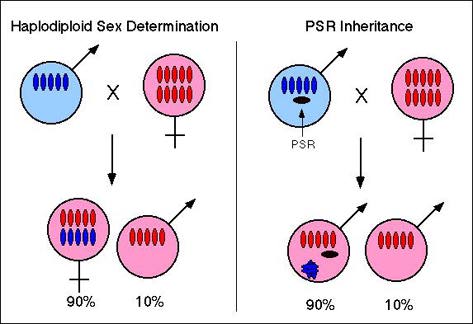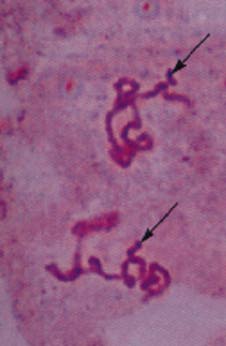|
Complex genetic systems appear to be vulnerable to "selfish" or "parasitic" genetic elements. Such elements enhance their own transmission relative to other elements in an individuals genome, but are either neutral or detrimental to the organisms fitness. "Genetic conflict" between selfish and other elements within the genome could be a motor for evolutionary change. I am particularly interested in the potential role of selfish genetic elements and genetic conflict in the evolution of sex determination. I have been conducting detailed genetic, population and molecular evolutionary studies of the sex ratio distorter system found in the parasitic wasp Nasonia vitripennis. N. vitripennis has an usual assemblage of "selfish" sex ratio distorters, including PSR (paternal sex ratio), a B chromosome transmitted through males that causes all-male families, SK (sonkiller) a maternally inherited bacterium that causes lethality of male eggs and MSR (maternal sex ratio), a cytoplasmically inherited element that causes nearly all-female families.
Recent research has focused on evolution of the PSR chromosome. Paternal Sex Ratio (PSR) is a non-vital supernumerary chromosome found in some natural population of N. vitripennis. The PSR chromosome is the most extreme example of a selfish genetic element so far found in any organism. Males unfortunate enough to carry PSR fail to transmit their genetic material (other than PSR) to the next generation. PSR is inherited through the sperm and causes improper condensation and loss of the paternal set of chromosomes following the first mitotic division of the unfertilized egg (Werren et al 1987, Reed and Werren, 1995). Due to haplodiploid sex determination of wasps, this results in all-male progeny. The new haploid complement is maternally derived and it will subsequently be destroyed by PSR in the next generation. Thus, PSR "jumps" from one haploid set to another, destroying each genome with which it is associated. |
||
 |
PSR can be used to study (1) evolution of selfish DNA, (2) chromosome evolution, and (3) mechanisms of chromosome condensation in early development. I have combined population genetic, molecular genetic, and cytogenetic approaches to study this chromosome. Field studies have shown that PSR is restricted in its distribution to the great basin region of North America, occurring at frequencies of between 0-10%. Both theory (Werren & Beukeboom 1993) and laboratory population experiments (Beukeboom and Werren 1992) indicate that the subdivided population structure of these wasps probably plays an important role in reducing the frequency of this selfish element and that the MSR element enhances its frequency. These studies represent one of the more clear-cut illustrations of interdemic (group) selection operating on a specific genetic element.
The Nasonia sex ratio distorter system shows promise as a model system for studying the coevolutionary dynamics of selfish genetic elements and their interplay with the host genome and population structure.
Selected Publications
(click here to get pdf files for some of the papers below)
McAllister, B.F., L.W. Beukeboom and J.H. Werren. 2004. Site-specific mapping of the paternal-sex-ratio (PSR) chromosome. Heredity 92 (1): 5-13.
Werren, J.H., M.J. Hatcher, and H.C.J. Godfray. 2002. Maternal-Offspring Conflict Leads to the Evolution of Dominant Zygotic Sex Determination. Heredity 88:102-111.
Hurst, G.D.D. and J.H. Werren. 2001. The role of selfish genetic elements in eukaryotic evolution. Nature Reviews 2:597-606.
Werren, J.H. and M. Hatcher. Maternal - zygotic gene conflict over sex determination: Effects of inbreeding. Genetics Genetics 2000 155: 1469-1479.
McAllister, B.F. and J.H. Werren 1999. Evolution of tandemly repeated sequences: What happens at the end of an array? J. Mol. Evol. 48:469-481.
Werren, J.H. and L. Beukeboom. 1998. Sex Determination, Sex Ratios and Genetic Conflict. Ann. Rev. Ecol. & Systematics 29:233-261.
Werren, J.H. 1998. Wolbachia and speciation. in Endless Forms: Species and Speciation, (D. Howard and S Berlocher, eds). pp. 245-260. Oxford University Press.
Werren, J.H. and S. O'Neill 1997. The evolution of heritable symbionts. In Influential Passengers:inherited microorganisms and arthropod reproduction. [S. O'Neill, A. Hoffman and J.H. Werren, eds] Oxford University Press
McAllister, B.F. and J.H. Werren 1997. Phylogenetic analysis of a retrotransposon with implications for strong evolutionary constraints on reverse transcriptase. Mol. Biol. &Evol. 14:69-80.
Werren, J.H. 1994. Genetic invasion of the insect body snatchers. Natural History 103(6):36-38.
Reed, K.M., L.W. Beukeboom, D. Eickbush and J.H. Werren. 1994. Junctions between repetitive DNA's on the Paternal Sex Ratio (PSR) chromosome: Association of palindromes with recombination. J. Mol. Evol. 38:352-362.
Beukeboom, L.B. and J.H. Werren. 1993. Transmission and expression of the parasitic Paternal Sex Ratio (PSR) chromosome. Heredity 70:437-443.
Werren, J.H. and L. Beukeboom. 1993. Population genetics of a parasitic chromosome: Theoretical analysis of PSR in subdivided populations. Amer. Natur. 142:224-241.
Beukeboom, L. and J.H. Werren. 1992. Population genetics of a parasitic chromosome: Experimental analysis of PSR in subdivided populations. Evolution 46(5):1257-1268.
Eickbush, D., T. Eickbush and J.H. Werren. 1992. Molecular characterization of repetitive DNA sequences from a B chromosome. Chromosoma 101:575-583
Werren, J.H., U. Nur., and C.-I. Wu. 1988. Selfish genetic elements. Trends in Ecol.& Evolution 3:297-302.
Nur, U., J.H. Werren, D. Eickbush, W. Burke and T. Eickbush, 1988. A "selfish" B chromosome that enhances its transmission by eliminating the paternal chromosomes. Science 240:512-514.
Werren, J.H., U. Nur and D. Eickbush. 1987. An extrachromosomal factor which causes loss of paternal chromosomes. Nature 327:75-76.
Werren, J.H. 1987. The coevolution of autosomal and cytoplasmic sex ratio factors. J. Theor. Biol. 124:317-334.
